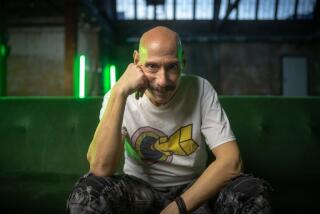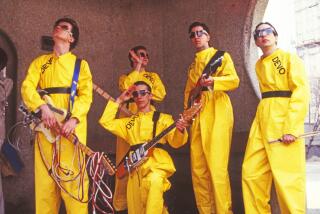The Sounds of Distortion Are Stereolab’s Muzak : The London group’s easy-listening music is for people reared on Sonic Youth. What the band’s created is escapism with flair.
- Share via
The London-based band Stereolab mixes Muzak (the kind that hipper dentists of the mid-’60s drilled teeth to) with organ-powered cocktail music (the kind Dean Martin scored with) and humming guitar distortion (the kind Pavement loves) and comes up with easy-listening music for a generation raised on Sonic Youth.
The quintet’s abstract blend may seem strictly for kitsch value at first, but it’s got a substance all its own. Stereolab, like other current bands that draw from lounge music (e.g. Combustible Edison) or techno’s ambient deejays who draw from Muzak (e.g. Orbital), creates escapism with flair. It’s a break from the reality-based rock and rap of today, without the nauseating mediocrity of rock lite.
Modern-day mutations of Muzak and lounge tunes, two very David Lynchian genres, are quirky and surreal enough to spare rock’s more discriminating listeners the embarrassment of being caught listening to grandma music. The recent experimentation also gives the feel of discovering something incredibly new and out of this world.
“I like music made for utilitarian reasons, like elevator music,” says Stereolab’s co-founder and guitarist Tim Gane. “You can take it out of its original purpose, then it’s just strange and very avant-garde. It’s like an odd little art world, but the people who made that music didn’t think it was strange at the time.”
Those people were Martin Denny, Arthur Lyman, et al.--arrangers whose wonderfully cheesy music has come to be known by the term exotica . Along with other forms of martini-sipping music, it’s become an inspiration for a new bunch of bands that includes L.A.’s Love Jones.
“Space Age bachelor-pad music,” says Stereolab’s Gane, tracing the group’s influences, “was made for bachelors of the ‘50s and early ‘60s when they got their spanking new hi-fis to entertain with.
“It was background music, but because stereo had just come out, it was extreme and over-emphasized in the sense of effects. Later, that turned into the use of strange instruments like Moogs in the late ‘60s, then peculiar, easy-listening music later.”
“We have our own interpretations of exotica, though,” says singer and organist Laetitia Sadier, who started Stereolab four years ago with Gane. “Like we did an album called ‘Space Age Bachelor Pad Music,’ which revolved around the smooth schmooze of the ‘50s, but it was our own mutation of it. It’s actually Stereolab’s sound.”
The band’s fourth album, the new “Mars Audiac Quintet,” expands on that theme, taking it to more surreal lengths with three organs, tambourines and dream-like harmonies by Sadier and second vocalist Mary Hansen.
“A third of our songs are based around a one-chord drone, on top of which you have melodic singing,” says Sadier. “It’s like putting two contraries together.”
The band’s organ sound is as fab as fab gets, reminiscent of the music piping through ice-skating rinks and malls 20 years ago.
“We didn’t look for that particular sound, we kind of stumbled on it,” says Sadier, who will appear with the band at the Troubadour on Aug. 26. “We happened to find this Farfisa organ, a great big plastic thing from the ‘70s, in a thrift shop. I just got paid from giving some French lessons to people, so we bought it. This incredible, heavy, compressed and loaded sound was like a huge shaver--Whaaah! That’s just something you can’t premeditate.”
“Sometimes people think it’s quite corny,” admits Gane. “To me it’s quite natural though. I never think we’re kitsch. We’re just going for sounds we like. I think we’re as modern as any modern-day band.”
More to Read
The biggest entertainment stories
Get our big stories about Hollywood, film, television, music, arts, culture and more right in your inbox as soon as they publish.
You may occasionally receive promotional content from the Los Angeles Times.










